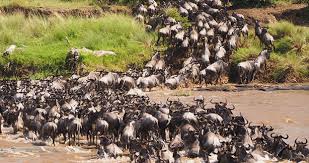
Wildebeest migration/FILE
A scientist has predicted that the Mara ecosystem could collapse in 10 years if the threats facing the gem are not urgently addressed.
Prof Joseph Ogutu said the escalating threats need attention from the highest office on the land.
“We are in an emergency and if nothing is done to reverse the threats, the ecosystem will collapse in 10 years,” he said.
Ogutu was speaking during the Second International Wildlife Scientific Conference at Lake Naivasha Resort in Nakuru county.
He said drivers of the declines include explosive human population growth, expanding livestock herds, declining rainfall and marked warming.
“The ultimate drivers, however, are land tenure and land use changes, governance, policy, institutional and market failures,” Ogutu said.
He said there is a mounting evidence showing precipitous wildlife declines worldwide, with severe losses across Africa.
He said they used systematic aerial surveys that sampled rangelands covering 88 per cent of Kenya’s land surface and reported in 2016 that national wildlife abundance had fallen by 68 per cent between 1977 and 2016.
“Losses were most acute (72 to 88 per cent) for warthog, lesser kudu, Thomson’s gazelle, eland, oryx, topi, hartebeest, impala, Grevy’s zebra and waterbuck,” Ogutu said.
He said the declines were widespread, affecting nearly all 21 rangeland counties.
“During the same period, cattle numbers shrank by 25.2 per cent, whereas sheep and goats rose by 76.3 per cent, camels by 13.1 per cent and donkeys by 6.7 per cent,” Ogutu said.
Consequently, livestock biomass increased from 3.5 times that of wildlife in 1977-1980 to 8.1 times in 2011–2013.
Ogutu said Narok county alone harboured roughly 30 per cent of Kenya’s remaining wildlife by 2013, while only Taita-Taveta, Laikipia, Garissa and Wajir increased their share, reflecting even steeper losses elsewhere.
“These trends call into serious question the effectiveness of current conservation policies, institutions and practices,” he said.
The theme of the three-day conference was: “Innovations in Wildlife Conservation Science and Practice for Socioeconomic Development".
Ogutu said his team of researchers reviewed Kenya’s land tenure, governance and conservation policy landscape and proposed remedial actions to restore rangeland health and wildlife populations.
The remedial actions include stronger investment in community and private conservancies.
“To diagnose the continuing crisis, we assembled data spanning 1885-2025 and applied dynamic, multi-scale cascading-causality and statistical analyses.”
Ogutu said they critically looked at the unplanned enclosure, adjudication, privatisation, individuation and subdivision from colonial times to the present and land use change.
They also looked at wildlife legislation, policy and institutions covering1889 to 2025.
He said there have been governance failures.
Ogutu said rapid human population growth, settlement expansion, urbanisation, fencing, infrastructure, agriculture and the degradation, fragmentation and contraction of wildlife ranges are some of the drivers that if not tackled will risk seeing some of the species get extinct.
“Resettlement and development schemes from independence that have contributed to dramatic destruction of wildlife habitats,” he said.
He also cited vermin control, licensed game cropping, poaching and both sanctioned and unsanctioned hunting as some of the drivers that affected wildlife population in the past.
To reverse some of the challenges, Ogutu said there is a need to adequately finance community and private conservancies; reform land-use and tenure policy to secure wildlife habitats, corridors and dispersal areas.
Other measures include strengthening governance, transparency and enforcement within conservation agencies; aligning macro-economic and sectoral policies (agriculture, infrastructure, tourism) with biodiversity goals.
Ogutu said there is a need to restore rangeland ecosystem services through participatory, climate-smart management.
“Implementing these interventions can help reverse current trajectories and safeguard Kenya’s unique wildlife heritage for future generations,” he said.
Wildlife Research and Training Institute CEO Dr Patrick Omondi said there is need to have in place measures that helped reversed the declines of elephants from 167,000 to 16,000.
Omondi said hunting decimated wildlife before it was banned in 70s.
“The expected census report for 2025 will have clear recommendations on how to deal with the declines. We need to take action like we did for rhinos and elephants for some of these species to survive,” Omondi said.
WRTI chair of the board Dr David Nkedianye said there is a small window for the declining species to be rescued from going extinct.
Nkedianye urged scientists to play an active role in decision-making tables.











